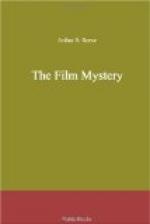Kennedy, undisturbed, walked to the side of Mackay. “I’ll leave Mr. Phelps and his house in your care,” he remarked, in a low voice.
Mackay grinned. I saw that the district attorney had little love for the owner of this particular estate in Tarrytown.
Kennedy led the way into the living room. Immediately the various people he had questioned clustered up with varying degrees of anxiety. Had the mystery been solved?
He gave them no satisfaction, but singled out Manton, who seemed eager to get away.
“Where is Millard? I would like to talk to him.”
“I’ll try to get him for you. Suppose—” Manton looked at his watch. “I should be in at the studio,” he explained. “Everything is at a standstill, probably, and—and so, suppose you and Mr. Jameson ride in with me in my car. Millard might be there.”
Kennedy brightened. “Good!” Then he looked back to catch the eye of Mackay. “Let everyone go now,” he directed. “Don’t forget to send me the samples of the body fluids and”—as an afterthought— “you’d better keep a watch on the house.”
VI
THE FIRST CLUE
Manton’s car was a high-powered, expensive limousine, fitted inside with every luxury of which the mind of even a prima donna could conceive, painted a vivid yellow that must have made it an object of attention even on its familiar routes. It was quite characteristic of its owner, for Manton, as we learned, missed no chance to advertise himself.
In the back with us was Werner, while the rest of the company were left to return to the city in the two studio cars which had brought them out in the morning. The director, however, seemed buried with his reflections. He took no part in the conversation; paid no attention to us upon the entire trip.
Manton’s mind seemed to dwell rather upon the problems brought up by the death of Stella than upon the tragedy itself. The Star’s photoplay editor once had remarked to me that the promoter was 90 per cent “bull,” and 10 per cent efficiency. I found that it was an unfair estimation. With all his self-advertisement and almost obnoxious personality, Manton was a more than capable executive in a business where efficiency and method are rare.
“This has been a hoodoo picture from the start,” he exclaimed, suddenly. “We have been jinxed with a vengeance. Some one has held the Indian sign on us for sure.”
Kennedy, I noticed, listened, studying the man cautiously from the corners of his eyes, but making no effort to draw him out.
“First there were changes to be made in the script, and for those Millard took his own sweet time. Then we were handed a lot of negative which had been fogged in the perforator, a thing that doesn’t happen once in a thousand years. But it caught us just as we sent the company down to Delaware Water Gap. A whole ten days’ work went into the developer at once. Neither of the camera men caught the fog in their tests because it came in the middle of the rolls. Everything had to be done over again.




